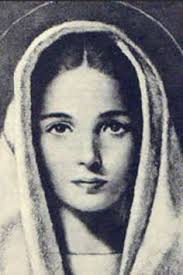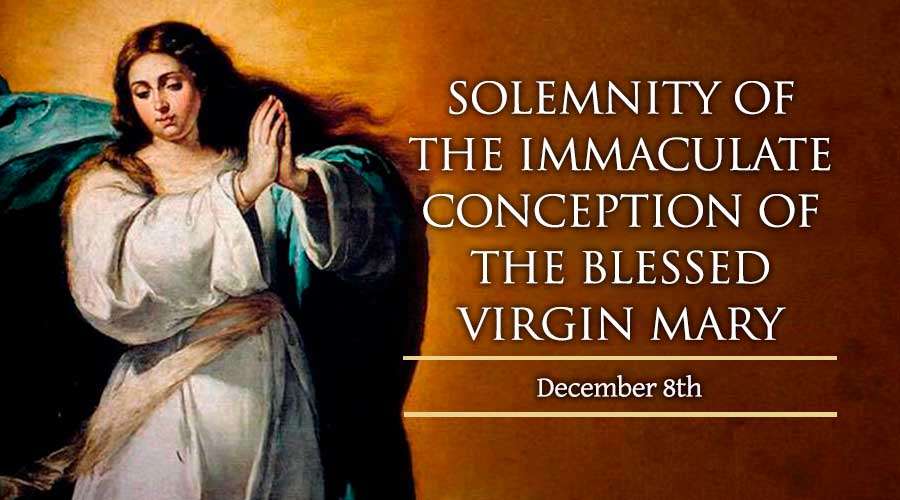WHEN ATE ELLA texted me an invite to the third in a series of talks organized by the Diocesan Faith and Formation Commission, I could not say no for many reasons. One, I missed the first of those talks; two, I attended the second one but had to leave early because of another commitment; and three, I promised her my support to her one-woman ministry and this was the day of delivery.
There was even a reward to keeping my word. She and her husband, Kuya Bobby, picked me up in the morning of that Saturday on their way to Jesus, Lord of Divine Mercy Parish, the venue of the activity. Loyal parishioners of the 7 member-churches of the Holy Spirit vicariate joined us in the exercise.
Always assigned as Emcee (and never minding the task), Ate Ella called on Rev. Fr. Joseph Buslon, JLDM Parish Priest, to welcome the congregation and lead the opening prayer. After which, Ate Ella introduced Ate Vien to introduce the guest speaker and his subject, “Mary, Mother and Disciple of Christ.” Rev. Fr. Aristeo de Leon was no stranger to those present, least of whom Ate Vien, who goes back with the prie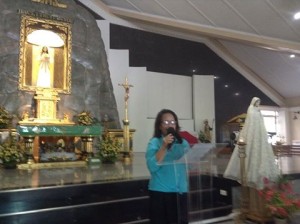 st to their formation days before Msgr. Romy Ranada took over as the commission head. Evidently, Fr. Aris’ rapport with the flock did not diminish with the gap. From his initial crack at humor, to teaching and doing with them the action of the song “Amare et Servire” (and, towards the wrap-up, “Doce Me Facere,” to the animated delineation of his discourse, Fr. Aris had the audience in the palm of his hand or, to put it more aptly, gravitating to his smile-suffused speech.
st to their formation days before Msgr. Romy Ranada took over as the commission head. Evidently, Fr. Aris’ rapport with the flock did not diminish with the gap. From his initial crack at humor, to teaching and doing with them the action of the song “Amare et Servire” (and, towards the wrap-up, “Doce Me Facere,” to the animated delineation of his discourse, Fr. Aris had the audience in the palm of his hand or, to put it more aptly, gravitating to his smile-suffused speech.
 st to their formation days before Msgr. Romy Ranada took over as the commission head. Evidently, Fr. Aris’ rapport with the flock did not diminish with the gap. From his initial crack at humor, to teaching and doing with them the action of the song “Amare et Servire” (and, towards the wrap-up, “Doce Me Facere,” to the animated delineation of his discourse, Fr. Aris had the audience in the palm of his hand or, to put it more aptly, gravitating to his smile-suffused speech.
st to their formation days before Msgr. Romy Ranada took over as the commission head. Evidently, Fr. Aris’ rapport with the flock did not diminish with the gap. From his initial crack at humor, to teaching and doing with them the action of the song “Amare et Servire” (and, towards the wrap-up, “Doce Me Facere,” to the animated delineation of his discourse, Fr. Aris had the audience in the palm of his hand or, to put it more aptly, gravitating to his smile-suffused speech.His opening salvo was the star that Mary was described as in terms of discipleship. She was the central figure in an encyclical because she carried Christ in her womb, gave birth to Him, sought Him in the temple (even if she and husband Joseph were rebuffed) and suffered His passion and death in silence. She was silent because she knew all along, when she said “Yes” to be the handmaid of the Lord that, as His servant, it will be done according to His word. She knew the great risks involved, like signing her own death warrant, but surrendered completely, without qualms nor complaint. She knew about Abraham’s holocaust at Mt. Moriah, and hoped the same grace that saved Isaac would spare her Son, but sustained her obedient silence 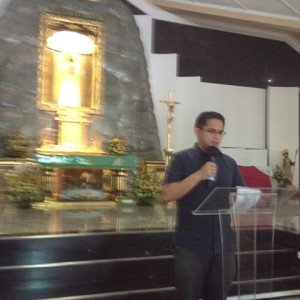 when it did not come to pass. Abraham’s and her parallel surrender made them the father and mother, respectively, of all believers.
when it did not come to pass. Abraham’s and her parallel surrender made them the father and mother, respectively, of all believers.
 when it did not come to pass. Abraham’s and her parallel surrender made them the father and mother, respectively, of all believers.
when it did not come to pass. Abraham’s and her parallel surrender made them the father and mother, respectively, of all believers.Mary was favored by God from her immaculate conception to her being chosen to carry the SonGod in her womb because she was full of grace and sinless. God sent her the angels Michael, the godlike messenger who hailed her with a messianic message; Gabriel, who gave her virginal pregnancy strength; and Raphael, whose help was always at her side.
Our mother’s obedience was not tested when, finding Jesus in the temple after a long, frantic search, she was told that He should be in His Father’s house. The resistance would have demoralized someone of faint disposition. But, a maiden cut above all mothers, Mary demonstrated that she might not have the head to understand the profundity of her SonGod but she had a heart where she kept the word and pondered over It. At this juncture, and to put emphasis on where Mary has the Lord, Fr. Aris asked the audience to spell the word “heart” and tell him what is in the middle of it. “Ear” was the resounding reply. So he instructed them to raise their hands, hold their ears and, withdrawing from their hearing orifices, yet keeping their shape in both hands, put them together. The no-brainer hit home.
“To Jesus through Mary” is a mantra that makes Mary the most privileged of all the ap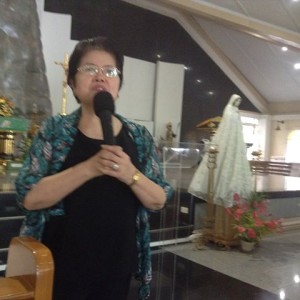 ostles because it shows Mary as the way. Vatican II speaks of her as the first and best believer and that pronouncement is credible because coming from a congress that opened the church doors to all and espoused Christ’s gospel of inclusion. It institutionalized Mary’s immaculate heart as the dwelling place of God, humility Himself.
ostles because it shows Mary as the way. Vatican II speaks of her as the first and best believer and that pronouncement is credible because coming from a congress that opened the church doors to all and espoused Christ’s gospel of inclusion. It institutionalized Mary’s immaculate heart as the dwelling place of God, humility Himself.
 ostles because it shows Mary as the way. Vatican II speaks of her as the first and best believer and that pronouncement is credible because coming from a congress that opened the church doors to all and espoused Christ’s gospel of inclusion. It institutionalized Mary’s immaculate heart as the dwelling place of God, humility Himself.
ostles because it shows Mary as the way. Vatican II speaks of her as the first and best believer and that pronouncement is credible because coming from a congress that opened the church doors to all and espoused Christ’s gospel of inclusion. It institutionalized Mary’s immaculate heart as the dwelling place of God, humility Himself.Mary’s concern is our soul for when she agreed to bear Jesus in her womb, she knew that the life that she carried will be offered for its salvation.
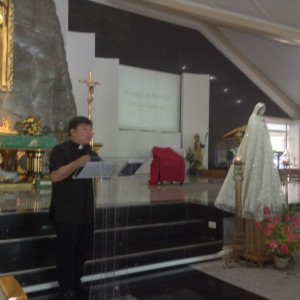
Among her many virtues, Mary’s simplicity so strikes Fr. Aris that he was constrained to recall people fussing all over her image, dressing it up in flamboyant fabrics, while all around her is a scenario of poverty and want. An irony of epic proportions, if her simple circumstances were taken into account. Mary’s simplicity and sinlessness were the only way for the SonGod to emerge. As then, people are so engrossed with personalities now they miss the presence. When Jesus’ mother and brothers wanted to go to Him but were unable to because of the crowd, someone said to Him that His mother and brothers were outside wanting to see Him. Jesus said, “My mother and brothers are those who hear the Word of God and obey it.” Indeed, Mary did not only do it, she lived it. Without fuss and fanfare.
The Lord is with her for she was not only sinless and full of grace but also privileged to pray for us, sinners, until the hour of our death. To learn from Mary how to pray means to join in her prayer. The kind that is ultimately self-giving in response to God’s love. If we say “Yes” as Mary did, God has the opportunity to lead His life in ours.
Her immaculate conception guaranteed her a place in heaven. St. Thomas, the doubter who only believed because he saw, might have redeemed his faith again without need for evidence, but missed the second opportunity of the miracle with Mary. He was not around when she rose, body and soul, from her sleep, into heaven. What he saw, however, were rose petals strewn all over where she slumbered. And, ruefully, he believed.
The open forum that followed would have kept the well-loved speaker forever were it not for another appointment. So inspired were the questions and earnestly did Fr. Aris address them all the crowd would not have minded giving him more than “Isang bagsak!” The actual answers hereunder are cut short for the sake of brevity.
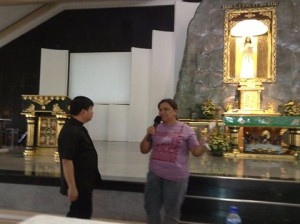
Q. Why does she have many titles? Ex. Our Lady of Guadalupe, Lourdes, Manaoag, etc.
A. The titles correspond to the places of her apparitions.
Q. And why, also, her many attributes in the litany of the rosary? Ex. “toreng garing.”
A. Those are tributes to the mother of God alongside her Son. “Toreng garing” is tower of ivory, for she is on high because of her purity, like ivory is pure. We say the litany with understanding, as when she was prophesied to be the mother of salvation. And gratitude, that she did not refuse or counter the prophesy.
Q. Why is she called mother of God?
A. Our dogma taught us that she is the mother of Jesus, God’s second person.
Q. If she went to heaven, can we apply to her the attributes yesterday, today and tomorrow?
A. I don’t want to talk about heaven and pretend I know. That attribute belongs to God and, knowing Mary’s fealty, she would not agree.
Q. Why does one of her images have a snake under her feet?
A. Scripture tells us that a woman will crush the head of a serpent. The symbol of the blue mantle is protection against evil.
Q. Why is she still called blessed virgin even after giving birth?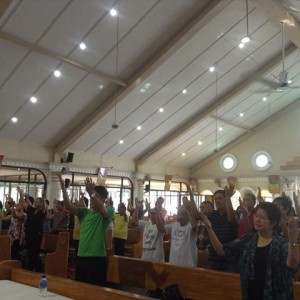

A. Our dogma explains that she conceived by the power of the Holy Spirit. Ergo, no human was involved in her holy pregnancy.
The last question was about “Ginoo” which the asker thought as inappropriate to address Mary with. Fr. Aris explained that it is a matter of translation and, if it is awkward to say, one can always shift to English.
Capping the symposium was a number from the JLDMP Choir which rendered a Marian hymn, “Ang Puso Ko’y Nagpupuri.” They were joined by the audience, who knew by heart the Tagalog translation of the Magnificat, Mary’s canticle of praise for her God and ours.


